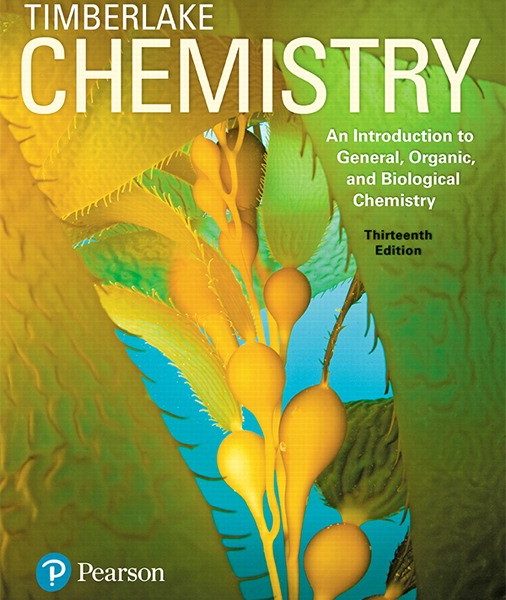This is completed downloadable of Test Bank for Chemistry An Introduction to General Organic and Biological Chemistry 13th Edition by Timberlake

Product Details:
- ISBN-10 : 0134421353
- ISBN-13 : 978-0134421353
- Author: Karen Timberlake
Chemistry: An Introduction to General, Organic, and Biological Chemistry, 13th Edition is the ideal resource for anyone interested in learning about allied health. Assuming no prior knowledge of chemistry, author Karen Timberlake engages readers with her friendly presentation style, revealing connections between the structure and behavior of matter and its role in health and the environment. Aiming to provide a better learning experience, the text highlights the relevance of chemistry through real-world examples. Activities and applications throughout the program couple chemistry concepts with health and environmental career applications to help readers understand why the content matters. The text also fosters development of problem-solving skills, while helping readers visualize and understand concepts through its engaging figures, sample problems, and concept maps.
The 13th Edition expands on Karen Timberlake’s main tenets: relevance, a clinical focus, educational research, and learning design. New applications added to questions and problem sets emphasize the material’s relevance, while updated chapter openers with follow-up stories help readers form a basis for making decisions about issues concerning health and the environment. New problem-solving tools in this edition, including Try it First and Connect, urge readers to think critically about problem-solving while learning best practices.
Table of Content:
1 Measurements 1 1.1 Scientific Method: Thinking like a Scientist 2 1.2 Measurement and Scientific Notation 5 Explore Your World Units Listed on Labels 7 1.3 Measured Numbers and Significant Figures 10 1.4 Significant Figures in Calculations 13 1.5 Prefixes and Equalities 17 1.6 Writing Conversion Factors 21 Explore Your World SI and Metric Equalities on Product Labels 23 1.7 Problem Solving 25 Guide to Problem Solving Using Conversion Factors 26 1.8 Density 32 Explore Your World Sink or Float? 35 Health Note Determination of Percentage of Body Fat 36 1.9 Temperature 37 Career Focus Surgical Technologist 39 Health Note Variations in Body Temperature 41 Concept Map 42 Chapter Review 42 Key Terms 43 Understanding the Concepts 44 Additional Questions and Problems 45 Challenge Questions 46 Answers 46 2 Atoms and Elements 49 2.1 Classification of Matter 50 2.2 Elements and Symbols 53 Health Note Latin Names for Elements in Clinical Usage 54 Environmental Note Toxicity of Mercury 56 2.3 The Periodic Table 56 Health Note Elements Essential to Health 58 Health Note Some Important Trace Elements in the Body 62 2.4 The Atom 63 Explore Your World Repulsion and Attraction 65 2.5 Atomic Number and Mass Number 66 Career Focus Optician 68 2.6 Isotopes and Atomic Mass 69 2.7 Electron Energy Levels 72 2.8 Electron Configurations 78 Guide Writing Electron Configurations with Sublevel Blocks 82 2.9 Periodic Trends 85 Concept Map 90 Chapter Review 90 Key Terms 91 Understanding the Concepts 92 Additional Questions and Problems 92 Challenge Questions 94 Answers 94 3 Nuclear Chemistry 97 3.1 Natural Radioactivity 98 Health Note Biological Effects of Radiation 102 3.2 Nuclear Equations 103 Guide Completing a Nuclear Equation 103 Environmental Note Radon in our Homes 104 Health Note Beta Emitters in Medicine 106 3.3 Radiation Measurement 109 Health Note Radiation and Food 111 3.4 Half-Life of a Radioisotope 113 Explore Your World Modeling Half-Lives 114 Environmental Note Dating Ancient Objects 115 3.5 Medical Applications Using Radioactivity 116 Health Note Radiation Doses in Diagnostic and Therapeutic Procedures 118 Health Note Other Imaging Methods 119 3.6 Nuclear Fission and Fusion 120 Environmental Note Nuclear Power Plants 123 Concept Map 124 Chapter Review 124 Key Terms 124 Understanding the Concepts 125 Additional Questions and Problems 126 Challenge Questions 127 Answers 127 4 Compounds and Their Bonds 130 4.1 Octet Rule and Ions 131 Health Note Some Uses for Noble Gases 133 Health Note Some Important Ions in the Body 135 4.2 Ionic Compounds 136 Career Focus Physical Therapist 137 4.3 Naming and Writing Ionic Formulas 139 Guide Naming Ionic Compounds with Metals that Form a Single Ion 139 Guide Naming Ionic Compounds with Variable Charge Metals 141 4.4 Polyatomic Ions 143 Health Note Polyatomic Ions in Bone and Teeth 145 Guide Naming Ionic Compounds with Polyatomic Ions 4.5 Covalent Compounds 147 Guide Writing Electron-Dot Formulas 4.6 Naming and Writing Covalent Formulas 154 Guide Naming Covalent Compounds with Two Nonmetals 155 Guide Writing Formulas for Covalent Compounds 155 4.7 Electronegativity and Bond Polarity 157 4.8 Shapes and Polarity of Molecules 161 Concept Map 167 Chapter Review 167 Key Terms 168 Understanding the Concepts 168 Additional Questions and Problems 169 Challenge Questions 170 Answers 170 5 Chemical Reactions and Quantities 174 5.1 Chemical Changes 175 5.2 Chemical Equations 177 Guide Balancing a Chemical Equation 179 5.3 Types of Reactions 182 Health Note Smog and Health Concerns 186 5.4 Oxidation-Reduction Reactions 186 Explore Your World Oxidation of Fruits and Vegetables 188 5.5 The Mole 189 Guide Calculating the Atoms or Molecules of a Substance 5.6 Molar Mass 193 Explore Your World Calculating Moles in the Kitchen 195 Guide Calculating the Moles (or Grams) of a Substance from Grams(or Moles) 195 5.7 Mole Relationships in Chemical Equations 198 Guide Using Mole-Mole Factors 200 5.8 Mass Calculations for Reactions 201 Guide Calculating the Masses of Reactants and Products in a Chemical Reaction 202 5.9 Percent Yield and Limiting Reactants 204 Guide Calculations for Percent Yield 205 Concept Map 211 Chapter Review 211 Key Terms 212 Understanding the Concepts 213 Additional Questions and Problems 214 Challenge Questions 215 Answers 216 6 Energy and Matter 218 6.1 Energy 219 6.2 Energy in Chemical Reactions 222 Guide Calculations Using Heat of Reaction (?H) 224 Health Note Hot Packs and Cold Packs 225 6.3 Specific Heat 226 Guide Calculations Using Specific Heat 228 Environmental Note Global Warming 229 6.4 Energy and Nutrition 230 Explore Your World Counting Calories 232 Health Note Losing and Gaining Weight 233 6.5 States of Matter 233 6.6 Changes of State 237 Guide Calculations Using Heat of Fusion/Vaporization Career Focus Histologist 239 Health Note Steam Burns 241 Concept Map 246 Chapter Review 246 Key Terms 247 Understanding the Concepts 247 Additional Questions and Problems 248 Challenge Questions 249 Answers 250 7 Gases 252 7.1 Properties of Gases 253 Explore Your World Forming a Gas 256 7.2 Gas Pressure 256 Health Note Measuring Blood Pressure 258 7.3 Pressure and Volume (Boyles' Law) Guide Using the Gas Laws 259 Health Note Pressure-Volume Relationship in Breathing 260 7.4 Temperature and Volume (Charles' Law) 262 7.5 Temperature and Pressure (Gay-Lussac's Law) 264 7.6 The Combined Gas Law 267 7.7 Volume and Moles (Avogadro's Law) 269 Guide Using Molar Volume 272 Guide Using Molar Volume for Reactions 273 7.8 The Ideal Gas Law 274 7.9 Partial Pressures (Dalton's Law) 277 Health Note Blood Gases 279 Health Note Hyperbaric Chambers 280 Concept Map 281 Chapter Review 281 Key Terms 282 Understanding the Concepts 282 Additional Questions and Problems 283 Challenge Questions 284 Answers 284 8 Solutions 286 8.1 Solutions 287 Health Note Water in the Body 289 Explore Your World Like Dissolves Like 292 8.2 Electrolytes and Nonelectrolytes 292 Health Note Electrolytes in Body Fluids 296 8.3 Solubility 297 Health Note Gout and Kidney Stones: A Problem of Saturation in Body Fluids 298 Explore Your World Preparing Solutions 299 Guide Writing Net Ionic Equations for Formation of an Insoluble Salt 302 8.4 Percent Concentration 305 Guide Calculating Solution Concentration 306 Guide Using Concentration to Calculate Mass or Volume 307 8.5 Molarity and Dilution 309 Guide Calculating Dilution Quantities 312 Guide Calculations Involving Solutions in Chemical Reactions 313 8.6 Properties of Solutions 315 Health Note Colloids and Solutions in the Body 315 Explore Your World Everyday Osmosis 318 Health Note Dialysis by the Kidneys and the Artificial Kidney 321 Concept Map 322 Chapter Review 323 Key Terms 323 Understanding the Concepts 324 Additional Questions and Problems 325 Challenge Questions 326 Answers 327 9 Chemical Equilibrium 329 9.1 Rates of Reactions 331 Environmental Note Catalytic Converters 9.2 Chemical Equilibrium 335 9.3 Equilibrium Constants 338 Guide Writing the Kc Expression Guide Calculating the Kc Value 9.4 Using Equilibrium Constants 343 Guide Using the Kc Value 9.5 Changing Equilibrium Conditions: Le Chatelier's Principle 349 Health Note Oxygen-Hemoglobin Equilibrium and Hypoxia . Health Note Homeostasis: Regulation of Body Temperature Concept Map 360 Chapter Review 260 Key Terms 361 Understanding the Concepts 361 Additional Questions and Problems 362 Challenge Questions 363 Answers 363 10 Acids and Bases 365 10.1 Acids and Bases 366 10.2 Bronsted-Lowry Acids and Bases 368 10.3 Strengths of Acids and Bases 372 10.4 Ionization of Water Guide Calculating [H3O+] and [OH_] in Aqueous Solutions 10.5 The pH Scale 381 Health Note Stomach Acid, HCl Guide Calculating pH of an Aqueous Solution Explore Your World Using Vegetables and Flowers as pH Indicators 10.6 Reactions of Acids and Bases 388 Environmental Note Acid Rain Guide Balancing an Equation for Neutralization Health Note Antacids Guide Calculations for an Acid-Base Titration 10.7 Acid-Base Properties of Salt Solutions 294 10.8 Buffers 397 Guide Calculating pH of a Buffer Health Note Buffers in the Blood Concept Map 402 Chapter Review 402 Key Terms 403 Understanding the Concepts 403 Additional Questions and Problems 404 Challenge Questions 404 Answers 405 11 Introduction to Organic Chemistry: Alkanes 407 11.1 Organic Compounds 408 11.2 Alkanes 411 11.3 Alkanes with Substituents 415 Guide Naming Alkanes Guide Drawing Alkane Formulas Health Note Common Uses of Haloalkanes 11.4 Properties of Alkanes 423 Explore Your World Combustion Health Note Incomplete Combustion Environmental Note Crude Oil Environmental Note CFCs and Ozone Depletion 11.5 Functional Groups 430 Career Focus Laboratory Technologist Environmental Note Functional Groups in Some Familiar Compounds Concept Map 436 Chapter Review 436 Summary of Naming 437 Summary of Reactions 437 Key Terms 437 Understanding the Concepts 438 Additional Questions and Problems 439 Challenge Questions 440 Answers 441 12 Unsaturated Hydrocarbons 444 12.1 Alkenes and Alkynes 445 Explore Your World Ripening Fruit 446 Guide Naming Alkenes and Alkynes 447 Environmental Note Fragrant Alkenes 449 12.2 Cis-Trans Isomers Environmental Note Pheromones in Insect Communication 450 Health Note Cis-Trans Isomers for Night Vision 451 Explore Your World Modeling Cis-Trans Isomers 452 12.3 Addition Reactions 452 Explore Your World Unsaturation in Fats and Oils 453 Health Note Hydrogenation of Unsaturated Fats 454 12.4 Polymers of Alkenes 459 Explore Your World Polymers and Recycling Plastics 462 12.5 Aromatic Compounds 462 Health Note Some Common Aromatic Compounds 463 Health Note Polycyclic Aromatic Hydrocarbons (PAHs) 465 12.6 Properties of Aromatic Compounds 465 Concept Map 468 Chapter Review 468 Summary of Naming 469 Summary of Reactions 469 Key Terms 470 Understanding the Concepts 470 Additional Questions and Problems 471 Challenge Questions 472 Answers 473 13 Alcohols, Phenols, Ethers, and Thiols 476 13.1 Alcohols, Phenols, and Thiols 477 Guide Naming Alcohols 478 Explore Your World Alcohols in Household Products 479 Health Note Some Important Alcohols and Phenols 480 13.2 Ethers 484 Guide Naming Ethers 485 Health Note Ethers as Anesthetics 486 13.3 Physical Properties of Alcohols, Phenols, and Ethers 488 13.4 Reactions of Alcohols and Thiols 491 Health Note Oxidation of Alcohol in the Body 496 Concept Map 499 Chapter Review 499 Summary of Naming 500 Summary of Reactions 500 Key Terms 500 Understanding the Concepts 501 Additional Questions and Problems 502 Challenge Questions 504 Answers 504 14 Aldehydes, Ketones, and Chiral Molecules 507 14.1 Aldehydes and Ketones 508 Guide Naming Aldehydes 509 Environmental Note Vanilla 511 Guide Naming Ketones 512 Health Note Some Important Aldehydes and Ketones 513 14.2 Physcial Properties of Aldehydes and Ketones 515 14.3 Oxidation and Reduction of Aldehydes and Ketones 517 14.4 Addition Reactions of Aldehydes and Ketones 522 14.5 Chiral Molecules 526 Health Note Enantionmers in Biological Systems 532 Concept Map 534 Chapter Review 534 Summary of Naming 535 Summary of Reactions 535 Key Terms 535 Understanding the Concepts 536 Additional Questions and Problems 537 Challenge Questions 540 Answers 540 15 Carbohydrates 15.1 Carbohydrates 15.2 Structures of Monosaccharides Health Note Hyperglycemia and Hypoglycemia 15.3 Cyclic Structures of Monosaccharides 15.4 Chemical Properties of Monosaccharides Health Note Testing for Glucose in Urine 15.5 Disaccharides Explore Your World Sugar and Sweeteners Health Note How Sweet is My Sweetener? Career Focus Phlebotomist Health Note Blood Types and Carbohydrates 15.6 Polysaccharides Explore Your World Polysaccharides Concept Map Chapter Review Summary of Carbohydrates Summary of Reactions Key Terms Understanding the Concepts Additional Questions and Problems Challenge Questions 16 Carboxylic Acids and Esters 16.1 Carboxylic Acids Guide Naming Carboxylic Acids Health Note Alpha Hydroxy Acids 16.2 Properties of Carboxylic Acids Health Note Carboxylic Acids in Metabolism 16.3 Esters Health Note Salicylic Acid and Aspirin Environmental Note Plastics 16.4 Naming Esters Guide Naming Esters 16.5 Properties of Esters Environmental Note Cleaning Action of Soaps Concept Map Chapter Review Summary of Naming Summary of Reactions Key Terms Understanding the Concepts Additional Questions and Problems Challenge Questions Answers 17 Lipids 17.1 Lipids 17.2 Fatty Acids Explore Your World Solubility of Fats and Oils Health Note Omega-3- Fatty Acids in Fish Oils 17.3 Waxes, Fats, and Oils 17.4 Chemical Properties of Triacylglycerols Health Note Olestra: A Fat Substitute Health Note Trans Fatty Acids and Hydrogenation Explore Your World Types of Fats 17.5 Glycerophospholipids 17.6 Sphingolipids Health Note Lipid Diseases 17.7 Steroids: Cholesterol and Steroid Hormones Health Note Anabolic Steroids 17.8 Cell Membranes Concept Map Chapter Review Key Terms Understanding the Concepts Additional Questions and Problems Challenge Questions Answers 18 Amines and Amides 18.1 Amines Health Note Amines in Health and Medicine Guide Naming of Amines 18.2 Properties of Amines 18.3 Heterocyclic Amines and Alkaloids Health Note Synthesizing Drugs 18.4 Amides Health Note Amides in Health and Medicine 18.5 Hydrolysis of Amides Concept Map Chapter Review Key Terms Understanding the Concepts Additional Questions and Problems Challenge Questions Answers 19 Amino Acids and Proteins 19.1 Proteins and Amino Acids 19.2 Amino Acids as Acids and Bases 19.3 Formation of Peptides Career Focus Rehabilitation Specialist 19.4 Protein Structure: Primary and Secondary Levels Health Note Natural Opiates in the Body 19.5 Protein Structure: Tertiary and Quaternary Levels Health Note Essential Amino Acids Health Note Prions and Mad Cow Disease Health Note Sickle-Cell Anemia 19.6 Protein Hydrolysis and Denaturation Explore Your World Denaturation of Milk Protein Concept Map Chapter Review Key Terms Understanding the Concepts Additional Questions and Problems Challenge Questions Answers 20 Enzymes and Vitamins 20.1 Enzymes 20.2 Enzyme Action Health Note Isoenzymes as Diagnostic Tools Explore Your World Enzyme Activity 20.3 Factors Affecting Enzyme Activity 20.4 Enzyme Inhibition 20.5 Control of Enzyme Activity 20.6 Enzyme Cofactors and Vitamins Concept Map Chapter Review Key Terms Understanding the Concepts Additional Questions and Problems Challenge Questions Answers 21 Nucleic Acid and Protein Synthesis 21.1 Components of Nucleic Acids Career Focus Occupational Therapist 21.2 Primary Structure of Nucleic Acids 21.3 DNA Double Helix 21.4 DNA Replication 21.5 RNA and Transcription 21.6 Genetic Code 21.7 Protein Synthesis: Translation Health Note Many Antibiotics Inhibit Protein Synthesis 21.8 Genetic Mutations Explore Your World A Model for DNA Replication and Mutation 21.9 Recombinant DNA 21.10 Viruses Health Note Cancer Concept Map Chapter Review Key Terms Understanding the Concepts Additional Questions and Problems Challenge Questions Answers 22 Metabolic Pathways for Carbohydrates 22.1 Metabolism and Cell Structure 22.2 ATP and Energy Health Note ATP Energy and Ca2+ Needed to Contract Muscles 22.3 Important Coenzymes in Metabolic Pathway 22.4 Digestion of Carbohydrates Explore Your World Carbohydrate Digestion Health Note Lactose Intolerance 22.5 Glycolysis: Oxidation of Glucose 22.6 Pathways for Pyruvate 22.7 Glycogen Metabolism 22.8 Gluconeogenesis: Glucose Synthesis Concept Map Chapter Review Key Terms Understanding the Concepts Additional Questions and Problems Challenge Questions Answers 23 Metabolic Pathways and Energy Production 23.1 The Citric Acid Cycle Career Focus Physical Therapist 23.2 Electron Carriers Health Note Toxins: Inhibitors of Electron Transport 23.3 Electron Transport 23.4 Oxidative Phosphorylation and ATP Health Note ATP Synthase and Heating the Body 23.5 ATP Energy from Glucose Health Note Efficiency of ATP Production Concept Map Chapter Review Key Terms Understanding the Concepts Additional Questions and Problems Challenge Questions Answers 24 Metabolic Pathways for Lipids and Amino Acids 24.1 Digestion of Triacylglycerols Explore Your World Digestion of Fats 24.2 Oxidation of Fatty Acids 24.3 ATP and Fatty Acid Oxidation Health Note Stored Fat and Obesity Explore Your World Fat Storage and Blubber 24.4 Ketogenesis and Ketone Bodies Health Note Ketone Bodies and Diabetes 24.5 Fatty Acid Synthesis 24.6 Digestion of Proteins 24.7 Degradation of Amino Acids 24.8 Urea Cycle 24.9 Fates of the Carbon Atoms from Amino Acids 24.10 Synthesis of Amino Acids Health Note Homocysteine and Coronary Heart Disease Health Note Phenylketonurea(PKU) Concept Map Chapter Review Key Terms Understanding the Concepts Additional Questions and Problems Challenge Questions Answers Credits Glossary/Index
People Also Search:
chemistry an introduction to general organic and biological chemistry 13th edition
chemistry an introduction to general organic and biological chemistry 13th pdf
chemistry an introduction to general organic and biological chemistry 13th edition pdf
chemistry an introduction to general organic and biological chemistry 13th download scribd
chemistry an introduction to general organic and biological chemistry 13th test bank download pdf





